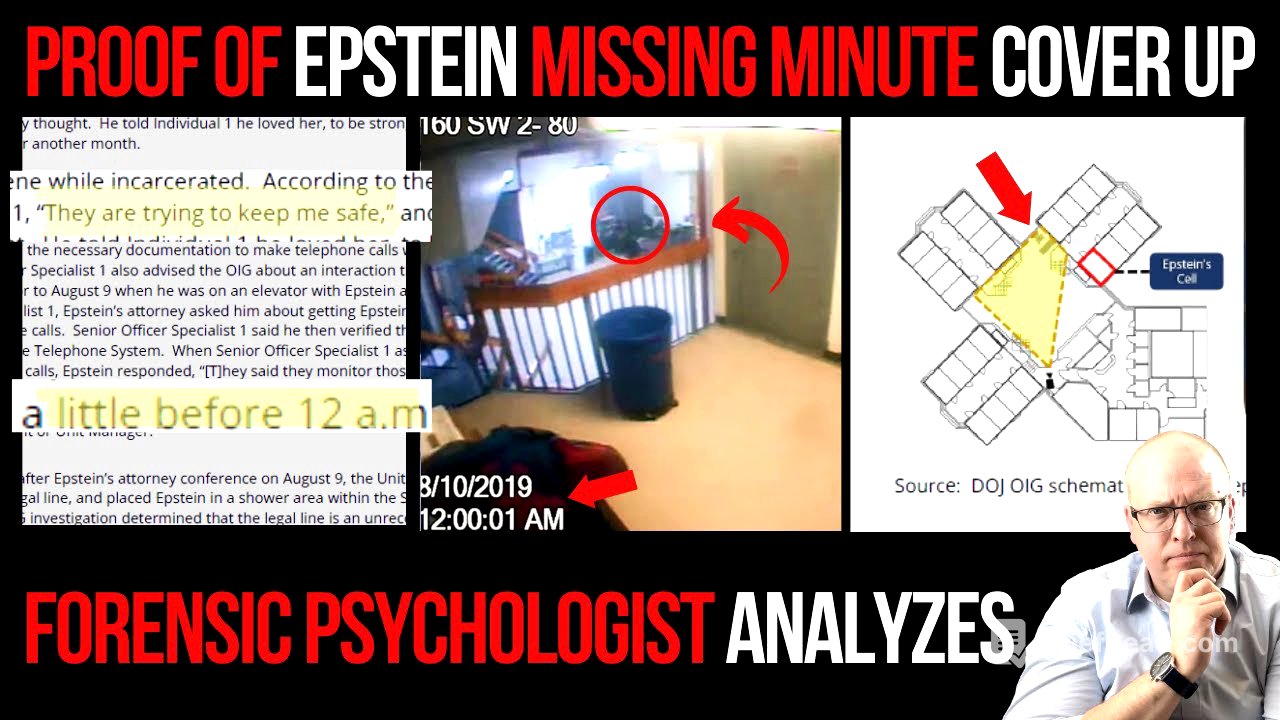TLDR;
Dr. G Explains reviews the missing minute from the Epstein jailhouse video and the Department of Justice's report on Epstein's death, initially dismissing the missing minute as a software glitch, but now believes it's more significant after reviewing the Office of the Inspector General's (OIG) report and inmate testimonies.
- The OIG report does not mention the missing minute, which is suspicious.
- Multiple inmates reported that the last check on Epstein occurred around midnight, contradicting the official timeline.
- An unmonitored phone call made by Epstein the night before his death raises further questions.
Introduction [0:00]
Dr. G, a clinical and forensic psychologist and body language expert, explains why the Epstein jailhouse video has a missing minute. She clarifies that her analysis constitutes her opinions and encourages viewers to like and subscribe for similar content. She admits she was wrong about the missing minute being a minor software issue. She will analyze the video footage around the missing time and compare it with the Department of Justice's Inspector General's report on Epstein's death.
Initial Observations of the Video Footage [0:24]
The video footage shows correctional officers at their desk, with Jeffrey Epstein's cell visible in the background. The video quality is poor, but there appears to be motion. The Office of the Inspector General stated that nobody approached Tier L, where Jeffrey Epstein was housed, between 10:40 p.m. and 6:30 a.m. Correctional officers were supposed to conduct checks every 30 minutes, but they falsified these checks. No officers are seen walking up to Tier L to check on Epstein between 12 and 1 a.m.
Department of Justice's Inspector General's Report [4:30]
On July 23rd, Epstein was found with an orange cloth around his neck. He initially claimed his cellmate tried to kill him but later recanted. The OIG found that the shoe staff did not conduct 30-minute rounds after 10:40 p.m. on August 9th. The video camera in the common area should have captured anyone entering Epstein's tier, but the video quality is poor. At 7:00 p.m. on August 9th, Epstein was allowed to make an unmonitored phone call to a New York City area code, purportedly to speak with his mother, but he spoke with someone else. The shoe staff did not conduct midnight, 3:00 a.m., or 5:00 a.m. inmate counts or any 30-minute rounds from 12:00 a.m. to 6:30 a.m.
Layout of the Special Housing Unit [7:46]
The report includes diagrams showing how to enter and exit the special housing unit and its relation to Epstein's cell. Tier L, where Epstein was housed, is directly visible from the officers' desk. A photograph shows the stairs close to the desk. On July 24th, after the incident on July 23rd, it was unclear whether Epstein had placed a string around his neck or if someone else did. The Bureau of Prison Special Investigative Services could not determine whether Epstein harmed himself or had been assaulted. A search of Epstein's cell revealed excess prison blankets, linens, and clothing, some of which had been ripped to create nooses.
Correctional Officers' Activities [10:37]
Correctional officers Noel and Thomas were seen moving around the shoe officer station, the shoe common area, and the shoe laundry entrance and exit areas on the morning of August 10th. Noel used the computer to search the internet for furniture sales and benefit websites and to read a news article about Epstein. Thomas used a computer briefly around 1:00 a.m. and 6:00 a.m. to search for motorcycle sales and sports news.
Epstein's Unmonitored Telephone Call [11:35]
Epstein placed an unrecorded, unmonitored telephone call to a telephone number in the local 646 area code using a non-inmate telephone system line on August 9th, 2019, from 6:58 p.m. to 7:19 p.m. No other BOP records exist regarding the unmonitored call, including the identity of the person called or a summary of the conversation. The unit manager handed the receiver to Epstein after a male answered, even though Epstein had requested to speak with his mother. The OIG investigation determined that Epstein did not speak with his mother, who died in 2004. He spoke with individual one, who declined to be interviewed by the OIG. Individual one's lawyer stated that individual one was in Belarus at the time of the call. During the call, Epstein said, "They are trying to keep me safe and that his case would take a little longer than he originally thought." He told individual one that he loved her, to be strong, and that he would not be able to call her again for another month. The Northeast Regional Director stated that Epstein's unmonitored telephone call was extremely concerning because it could have potentially led to Epstein's death.
Inmate Testimonies and Missing Minute [15:21]
The OIG interviewed three inmates assigned to the same shoe as Epstein who were housed in cells opposite Epstein's cell and therefore had a direct line of sight to Epstein's cell. Inmate 5 believed a count was last conducted within the shoe on August 9th, 2019, a little before 12:00 a.m. and said that no additional count was conducted after that time. Inmate 5 did not see or hear anyone go into Epstein's cell on the night of August 9th or the morning of August 10th prior to the male CO discovering Epstein. Inmate 6 believed the COs last checked on inmates in the shoe on August 10th between 12:30 a.m. and 1:00 a.m. Inmate 6 did not observe anyone entering Epstein's cell after Epstein returned from his legal visit, did not hear a noise that night, and said Epstein's door was not opened during the night. The OIG and the FBI interviewed seven inmates assigned to other tiers in the shoe, none of whom had any direct knowledge of how Epstein died. These inmates consistently reported that the shoe officers did not systematically conduct the counts and rounds as required on the evening Epstein died. The last round was either around 9:30 to 10 p.m. or 12:30 to 1 a.m. Several inmates told the OIG that before Epstein died, the shoe staff never conducted rounds at night. The camera cuts off right at the stairs, not in front of Epstein's cell. The report does not mention the missing minute.
Conclusion [21:18]
Dr. G concludes that the missing minute is more intentional than initially thought. The fact that the missing minute was not noted in the OIG report and the inmate testimonies suggest that something happened during that time. She finds it curious that the report does not specify the questions asked to the inmates or provide details about who they thought came in to check on them. She encourages viewers to share their thoughts and suggestions for further investigation.









